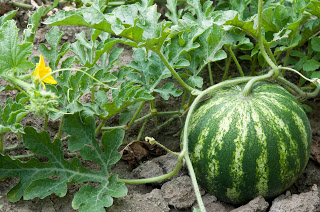The Ultimate Guide to Growing Organic Summer Watermelons

The days are getting longer and the sun seems to be shining a bit brighter… That’s right! It’s summertime! A favorite season among many people, summer is typically associated with long, carefree days at the beach, amazing backyard barbeques and deliciously fresh produce. Perhaps one of the most popular summer treats is watermelon, which features a refreshing fruity flavor enjoyed by everyone. Unfortunately, ripe organic watermelons tend to carry a hefty price at local grocery stores and farmers markets. It can be an extremely difficult feat to find the perfect, ruby red organic melon at a reasonable, low price. If you have a green thumb, however, you can plant and grow your own watermelons easily and be on your way to enjoying delicious summer fruits in just minutes! Follow our comprehensive guidelines below to plant the perfect summer treat!
Preparation
Before planting your watermelon seeds in your garden, keep in mind that this fruit thoroughly prefers hot to warm and humid climates. It is a widely known fact that watermelons are unable to grow in mild and cool temperatures. To make sure your seeds have the optimum growth and prevent germination, make sure to plant them when temperatures reach a minimum of 70 degrees Fahrenheit outdoors. Also, watermelon plants thrive in areas where they are fully exposed to the sun and they require good circulation in order to grow properly. Choose a site that will be able to provide the plant with as much sunlight as possible, for as long as possible throughout the entire day. Make sure to also choose a planting site that will avoid chilly winds, as watermelon vines are very tender and easily break when exposed to frost or cold temperatures.
Planting the Seeds
After finding the perfect, sunny spot to grow your fruit, you are now ready to plant your watermelon seeds. A good tip to follow in growing melons is to dig some organic fertilizer into the soil and make sure that the soil you plant your seeds in is slightly sandy and very well-drained. It is recommended that you buy watermelon seeds to plant versus purchasing seedlings at a nursery because watermelons are not able to grow properly when transplanted. When planting your seeds, place them in a hole that is about two feet around and one foot deep. Also remember that watermelons must be planted at least three feet apart, and some farmers and gardeners even prefer to lay them 12 feet apart! The distance between each planted seed varies depending on which type of watermelon you purchase. This is because different varieties of melons grow to be different sizes, thus they require different spacing requirements. After you decide where to plant your seeds and how far to space each of them, add some more fertilizer right before planting them, even if you had already previously placed some organic fertilizer in the same location.
Care and Upkeep

Many planters add plastic covers to their watermelon patches with slits evenly cut in it to allow the plant to grow. Doing so helps protect and aid the growth of your fruit in a variety of ways, as it keeps the heat inside and prevents pests from attacking the roots of the watermelon as they grow. Freshly planted watermelon seeds need about an inch of water per week, and once the plants’ flowers begin to sprout, any plastic covering that you may have added should be removed immediately. Removing the plastic covering will allow bees to pollinate them and further assist the growing process. When the watermelon plant has finally come to full bloom, wait about 35 to 40 days from that point. After the allotted time has passed, you are now ready to harvest your organic summer fruit and enjoy their delicious flavors!
Main Street Seed and Supply offers only the highest quality
watermelon seeds. Shop today and get started growing the perfect plant!